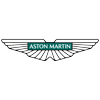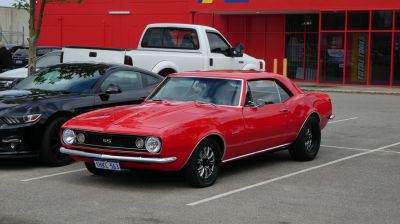 1994 Aston Martin DB7 Dimensions, Size & Specs
1994 Aston Martin DB7 Dimensions, Size & SpecsMeasurements of the 1994 Aston Martin DB7, engineered for optimal performance and comfort
| Dimensions | |
|---|---|
| Length: | 4631 mm182.3 in15.2 ft |
| Width: | 1820 mm71.7 in6.0 ft |
| Height: | 1268 mm49.9 in4.2 ft |
| Weight Specifications | |
| Curb Weight: | 1725 kg3803 lbs |
The Aston Martin DB7, produced from 1994 to 1999, is a distinguished luxury coupe combining refined British craftsmanship with impressive performance. As a hallmark of 1990s automotive elegance, the DB7 measures 4631 mm (182.2 inches) in length, 1820 mm (71.7 inches) in width, and stands at a low and sleek height of 1268 mm (49.9 inches). This coupe's well-proportioned dimensions give it a sporty yet sophisticated profile that balances aerodynamic efficiency with aesthetic appeal. Weighing in at 1725 kg (3804 lbs) curb weight, the DB7 strikes a balance between lightweight agility and the solid feel expected from a grand touring vehicle. Its size positions it comfortably within the luxury coupe segment, offering ample interior space for driver and passenger comfort without compromising on performance dynamics. The DB7 generation remains a celebrated model for collectors and enthusiasts alike, representing Aston Martin's commitment to style, engineering excellence, and timeless design.
Discover the standout features that make the 1994 Aston Martin DB7 a leader in its class
Have a question? Please check our knowledgebase first.
The Aston Martin DB7, produced from 1994 to 1999, measures 4631 mm (182.3 inches) in length, 1820 mm (71.7 inches) in width, and 1268 mm (49.9 inches) in height. These dimensions reflect the car's sleek grand tourer profile, balancing an elegant low-slung design with a comfortable cabin space. The width offers a stable footprint which complements the car's performance and handling, while the length provides ample room for a 2+2 seating layout. The relatively low height contributes to a sporty aesthetic and improved aerodynamics.
The curb weight of the Aston Martin DB7 is approximately 1725 kg (3802 lbs). This weight reflects the car's construction, which uses steel and aluminum components to balance structural rigidity and performance. A curb weight of this magnitude helps provide the DB7 with a solid and refined driving feel, contributing to its grand tourer characteristics. While not the lightest in its class, the weight supports smooth ride quality and stable high-speed cruising, while being carefully balanced to maintain agility and responsive handling typical of Aston Martin vehicles.
The Aston Martin DB7, with a length of 4631 mm (182.3 inches), width of 1820 mm (71.7 inches), and height of 1268 mm (49.9 inches), generally fits within the dimensions of a standard single-car home garage. Most standard garages have dimensions around 6 meters (20 feet) in length and 3 meters (10 feet) in width, which should comfortably accommodate the DB7. However, due to its relatively wide stance and low height, care should be taken when maneuvering in tighter spaces or older garages with narrow doors. Overall, the DB7's size strikes a good balance for enthusiasts wanting a luxurious sport coupe without requiring special garage accommodations.
The Aston Martin DB7 did not directly replace an earlier DB series car like the DB6 which ended production in 1970. Instead, the DB7 marked a significant restart for Aston Martin in the 1990s, incorporating a modern platform and design after a production hiatus in DB models. Compared to the earlier DB6 (1965-1970) which was longer at around 4826 mm (190 inches) and slightly wider, the DB7 is more compact but benefits from improved chassis dynamics, lightweight materials, and modern styling cues. The DB7's size is more suited to the contemporary grand tourer market of the 1990s, balancing classic Aston Martin design with modern engineering.
When compared with contemporary grand tourers like the Jaguar XK8 or the Porsche 928 from the mid to late 1990s, the Aston Martin DB7 holds a competitive size footprint. For example, the Jaguar XK8 measured roughly 4720 mm (185.8 inches) in length and 1830 mm (72 inches) in width, slightly larger than the DB7’s 4631 mm (182.3 inches) length and 1820 mm (71.7 inches) width. The Porsche 928, while similar in length at about 4680 mm (184.3 inches), is wider. The DB7’s lower height at 1268 mm (49.9 inches) makes it sleeker in profile compared to many rivals, emphasizing its sporty coupe styling. Overall, the DB7 merges classic Aston Martin elegance with competitive dimensions suited for high performance and luxury comfort.
The Aston Martin DB7 measures 1820 mm (71.7 inches) wide and 1268 mm (49.9 inches) tall, dimensions that provide key benefits for a grand tourer coupe. Its width offers a stable track that enhances cornering grip and high-speed stability without being overly wide to cause issues in narrow roads or parking areas. The sleek, low height aids aerodynamic efficiency and produces a sporty, elegant silhouette characteristic of Aston Martin designs. This low profile also lowers the center of gravity, contributing positively to the car’s handling dynamics and responsive driving feel.
At 1725 kg (3802 lbs), the Aston Martin DB7 is moderately heavy for a grand tourer coupe of its size and class. This weight comes from robust build quality and the inclusion of luxury features typical of Aston Martin cars. While not the lightest sports car, this curb weight offers benefits including enhanced ride comfort, solid road presence, and structural rigidity. It strikes a balance between performance and luxury, making the car comfortable for long-distance touring without compromising too much agility. The weight does mean it may not accelerate as sharply as some lighter competitors, but the powertrain design and chassis tuning accommodate this well, resulting in a refined and confident drive.
The Aston Martin DB7 showcases a distinctive combination of dimensions optimized for elegance and performance. Its length of 4631 mm (182.3 inches) and relatively wide stance of 1820 mm (71.7 inches) provide a substantial yet balanced grand touring footprint. The notably low height of 1268 mm (49.9 inches) gives the car a sleek coupe profile that is less common among competitors, many of which have higher rooflines for practicality. This low profile not only enhances aerodynamic performance but also gives it a visually striking stance. Coupled with classic Aston Martin design cues such as the elongated hood and flowing lines, these unique dimensional traits contribute to the DB7’s timeless appeal.
While the Aston Martin DB7’s exterior dimensions (4631 mm length, 1820 mm width, and 1268 mm height) suggest a compact coupe, the interior space is efficiently designed to accommodate passengers comfortably. The DB7 features a 2+2 seating layout, allowing seating for four, though rear seats are best suited for children or short trips given the car’s sporty proportions. The cabin is driver-oriented with high-quality materials and craftsmanship, maximizing space within a sleek design. Cargo capacity is modest, typical for grand tourers, with a trunk volume that can handle luggage for weekend trips but not as spacious as larger luxury sedans. Overall, the DB7 balances its exterior dimensions with practical interior usability for its class.
Throughout its production run from 1994 to 1999, the Aston Martin DB7 maintained consistent dimensions, with length at 4631 mm (182.3 inches), width at 1820 mm (71.7 inches), and height at 1268 mm (49.9 inches). There were no major changes in size as the model was refined but kept stable exterior measurements. Similarly, curb weight remained around 1725 kg (3802 lbs). However, refinements in technology, features, and mechanical upgrades during the production period focused more on performance enhancements and luxury rather than altering the overall size or weight. This consistency helped cement the DB7's identity as a classic grand tourer in the Aston Martin lineup.
Discover similar sized cars.

| Production: | 1966-1968 |
|---|---|
| Model Year: | 1967 |
| Length: | 4691 mm184.7 in |
| Width: | 1842 mm72.5 in |
| Height: | 1295 mm51.0 in |
